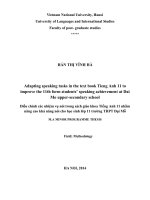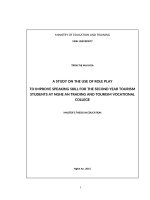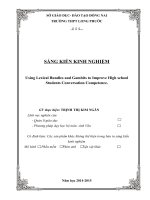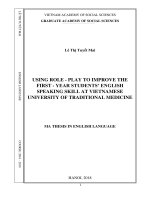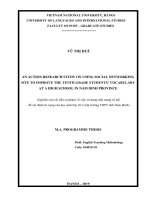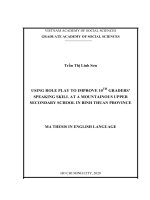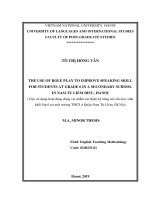USING SCRIPTED ROLE PLAY TO IMPROVE HIGH SCHOOL WEAK STUDENTS’ SPEAKING PERFORMANCES
Bạn đang xem bản rút gọn của tài liệu. Xem và tải ngay bản đầy đủ của tài liệu tại đây (484.74 KB, 82 trang )
MINISTRY OF EDUCATION AND TRAINING
VINH UNIVERSITY
----------------
TRẦN THỊ MAI
M. A. THESIS
USING SCRIPTED ROLE-PLAY TO IMPROVE HIGH SCHOOL
WEAK STUDENTS’ SPEAKING PERFORMANCES
SỬ DỤNG KĨ THUẬT ĐÓNG VAI CÓ KỊCH BẢN NHẰM CẢI THIỆN KĨ
NĂNG NÓI TIẾNG ANH CHO HỌC SINH YẾU
BẬC TRUNG HỌC PHỔ THÔNG
Major: Teaching English to Speakers of Other Language (TESOL)
Code: 60.14.01.11
NGHE AN- 2017
MINISTRY OF EDUCATION AND TRAINING
VINH UNIVERSITY
-----------------
TRẦN THỊ MAI
M. A. THESIS
USING SCRIPTED ROLE-PLAY TO IMPROVE HIGH SCHOOL
WEAK STUDENTS’ SPEAKING PERFORMANCES
SỬ DỤNG KĨ THUẬT ĐÓNG VAI CÓ KỊCH BẢN NHẰM CẢI THIỆN KĨ
NĂNG NÓI TIẾNG ANH CHO HỌC SINH YẾU
BẬC TRUNG HỌC PHỔ THÔNG
Major: Teaching English to Speakers of Other Language (TESOL)
Code: 60.14.01.11
SUPERVISOR: NGUYỄN THỊ QUYẾT, Ph.D
NGHE AN - 2017
ACKNOWLEDGEMENT
I gratefully acknowledge the encouragement and support of many individuals in assisting me
to accomplish this study.
First of all, I would like to express my deepest thanks to my beloved supervisor
Nguyen Thi Quyet, Ph.D for her valuable time, suggestions, guidance, and assistance in this
study. Without her help, the thesis would not have been completed.
I would also like to thank the students of the classes I visited in order to collect
information for my research. Without their help, this study could not have been
successful.
Finally, my thanks go to my colleagues, friends and especially my beloved
family. I feel greatly indebted to them for their essential help and encouragement.
i
STATEMENT OF AUTHORSHIP
I hereby acknowledge that this study is my own work. The data and findings discussed
in the thesis are true, used with permission, and have not been published elsewhere.
ii
TABLE OF CONTENTS
Page
CHAPTER 1: INTRODUCTION..........................................................................1
1.1. Rationale............................................................................................................. 1
1.2. Aims of the study................................................................................................3
1.4. Scope of study....................................................................................................3
1.5. Method of the study............................................................................................3
1.6. Organization of the thesis...................................................................................4
CHAPTER 2: THEORETICAL BACKGROUND...............................................5
2.1. Speaking skill.....................................................................................................5
2.1.1. Definition of speaking skill..........................................................................5
2.1.2. Types of spoken language............................................................................5
2.1.3. Characteristics of spoken language..............................................................6
2.1.4. Aspects of speaking skills.............................................................................8
2.1.5. Communicative competence........................................................................9
2.1.6. Teaching Speaking.......................................................................................9
2.1.6.1. Principles for teaching speaking..........................................................10
2.1.6.2. Types of classroom speaking performance...........................................13
2.1.6.3. Classroom speaking activities..............................................................16
2.1.6.4. Designing lesson plans.........................................................................18
2.1.6.5. The roles of the teacher and the students in speaking class..................19
2.1.7. Difficulties learners have when learning speaking.....................................20
2.1.8. The assessment of speaking skill................................................................21
2.2. Role-play..........................................................................................................22
2.2.1. The definition of role-play..........................................................................22
2.2.2. The Advantages of role-play.......................................................................24
2.2.3. Steps in applying role-play.........................................................................25
2.2.4. Types Role-plays........................................................................................31
2.2.4.1. Scripted role-play.................................................................................31
2.2.4.2. Unscripted role-play.............................................................................32
2.2.4.3. The strength of using Scripted role-play..............................................33
2.2.4.4. Memorization in role-plays..................................................................34
CHAPTER 3: METHODOLOGY.......................................................................35
iii
3.1. Research questions...........................................................................................35
3.2. Participants.......................................................................................................35
3.3. Materials...........................................................................................................35
3.4. Procedure..........................................................................................................37
CHAPTER 4: FINDINGS AND DISCUSSION..................................................40
4.1. Results..............................................................................................................40
4.1.1. The results of The general English test.......................................................40
4.1.2. Pre- and post-test results.............................................................................41
4.1.3. Results from Questionnaires.......................................................................48
4.2. Discussion........................................................................................................51
CHAPTER 5: CONCLUSION.............................................................................53
5.1 Conclusion.........................................................................................................53
5.2. Implications......................................................................................................54
5.3. Limitations of the study....................................................................................54
5.4. Suggestions for further study............................................................................55
REFERENCES......................................................................................................56
APPENDIX A...........................................................................................................I
APPENDIX B........................................................................................................IV
APPENDIX C.........................................................................................................V
APPENDIX D........................................................................................................VI
APPENDIX E.......................................................................................................VII
APPENDIX F......................................................................................................VIII
APPENDIX G........................................................................................................IX
APPENDIX H.........................................................................................................X
APPENDIX I.........................................................................................................XI
APPENDIX J........................................................................................................XII
APPENDIX K.....................................................................................................XIV
APPENDIX L......................................................................................................XIX
iv
LIST OF TABLES
Page
Table 3. 1: List the sixteen topics in the textbook “English 10”..............................36
Table 3. 2: The lesson plan’s time allocation...........................................................37
Table 4. 1: The average total scores and standard deviations of the general English
test in the experimental group and the control group..............................40
Table 4. 2: The means, medians and modes of the experimental group in the pre-test
and the post-test......................................................................................41
Table 4. 3: The means, medians and modes of the control group in the pre-test and
the post-test............................................................................................41
Table 4. 4: Student satisfaction levels in scripted role-play for improving speaking
skills ......................................................................................................49
v
LIST OF FIGURES
Page
Figure 4. 1: The improvement of students of the experimental group in all aspects of
speaking skills from the pre-test to the post-test.....................................43
Figure 4. 2: The grammar results of both groups in the pre-test and the post-test. . .44
Figure 4. 3: The vocabulary results of both groups in the pre-test and the post-test 45
Figure 4. 4: The pronunciation results of both groups in the pre-test and the post-test
...............................................................................................................46
Figure 4. 5: The comprehension results of both groups in the pre-test and the posttest..........................................................................................................47
Figure 4. 6: The fluency results of both groups in the pre-test and the post-test......48
Figure 4. 7: Students’ attitudes toward using scripted role-play..............................51
vi
ABSTRACT
Role-play is very prominent in English speaking classroom because it allows
students to have more oral practice in different social contexts and roles. The
purpose of this study was the to find out whether or not scripted role-play could
make a difference in improving weak students’ speaking skill achievement and
investigate the students’ attitudes toward using these activities in teaching speaking
skill. The population of research was 70 tenth grade students of Trieu Son 1 High
school in the academic year of 2016 - 2017 divided into two groups, experimental
group and control group. The author carried out the general English test, pre-test,
post test with questionnaires for students. The rubric was used to measure students’
speaking performance. The findings showed that (1) there was a significant
improvement in speaking skill of the weak students, (2) there was also a significant
mean difference between the speaking skill of the experimental and control group,
(3) The students were interested in scripted role play activities, they felt more
confident and relaxed when acting out roles in public. Hence, from the research
findings, it could be concluded that scripted role-play can significantly improve the
weak students’ speaking skill achievement in English teaching and learning
environment.
vii
CHAPTER 1: INTRODUCTION
1.1. Rationale
In this globalization era, English has become an the important means of
international communication. It plays recognizable roles in almost every society,
whether large or small, across the globe. Today, everyone needs to know English
in order to get connected with world communities and to exploit their knowledge
resources. Indeed, the use of English has been increasing throughout the world. The
increasing demand of good communication skills in English has activated English
teaching around the world (Richard, 2006). English language competence,
especially the ability to communicate in English becomes a primary concern of
teaching programs launched at any education level in countries. In Vietnam, today
English is taught in every level; Vietnamese students are required to study the
language from primary school to university. In fact, most of them spend more than
six years learning English through formal education. Despite such a long time of
learning English in school, the results of their studying immensely vary.
In teaching and learning English, there are four micro language skills, they are
speaking, listening, reading and writing. One of those components, speaking, as a
productive skill, seems intuitively the most important of all the four language skills
because it can distinctly show the correctness and language errors that a language
learner makes. As English teachers, we can see that in some English classes there
are few students who can speak the language fluently. The first problem faced by
students in speaking skill that they do not have sufficient vocabulary. As a result,
they find it difficult to express their ideas when the teacher wants them to speak in
English. The second problem is that the students feel afraid of making mistakes
when they converse in English. Therefore, many students are not confident to speak
and take part in classroom interactions. In addition to, A possible reason for this is
that the English classroom is too rigid. The students always sit and listen to the
teacher emphasizing the structure of language rather than participating in activities
that promote communication skills, or the development of even basic oral ability.
1
The activities for speaking skills in the English book are good, however, for
students who are eager for new knowledge and various activities, changing the
activities to make them more interesting is necessary which can contribute to the
success of the lesson as well as the final results. Many English teachers have
consequently shifted their lessons to make them more active by employing
Communicative Language Teaching (CLT). As the teaching method focuses on
providing students opportunities to use the target language, many activities are
introduced to the students in order to develop their speaking ability. One of the most
popular activities chosen by the teachers is role-play. It is demonstrated in a number
of studies that role-play helps to improve the students speaking ability effectively
(Alwahibee, 2004; Klanrit, 2007; Liu & Ding, 2009). Role-play has been considered
an effective approach in a communicative classroom to developing skills in
active listening, problem-solving, working as a team, and communicating
effectively, among others (Rao, 2011).
The role-play activities typically used in a language classroom can be
classified into two types: scripted and non-scripted role-plays. In scripted roleplay, the students have to act out through the script given on assigned situations
by using the target language in pairs or in small groups. In non-scripted role-play,
on the other hand, they are asked to act out a conversation in front of the class
without preparing or writing the script in advance (Byrne, 1986). When doing
the scripted role-play, the students have time to prepare the scripts and rehearse
them to achieve the ability to speak smoothly. Students, especially with low
English proficiency, often find scripted role-plays easier to handle, thus being a
more popular choice in English conversation classrooms (Chotirat, 2010). Nonscripted role-play, on the other hand, seems to be far too complicated, given the
fact that students have limited knowledge of the target language and little
opportunity to prepare for it.
Scripted role-play therefore seems to be a more appropriate choice of
activity to promote meaningful communication in a low-level language
2
classroom. Furthermore, there have been few studies that examined the
implementation of this role-play type for weak students in Vietnam .
Based on these reasons, the researcher is interested in conducting a study on
“Using scripted role-play to improve high school weak students’ speaking
performances”
1.2. Aims of the study
This study aims at determining how scripted role-plays can help to improve
oral English performances of high school weak students and examining the
students’ attitudes toward using scripted role play activities in teaching and learning
English.
1.3. Research questions
From the explanation above, the research questions in this study can be formulated
as follows:
1. What extent is using scripted role-play to improve weak students’ speaking
performances ?
2. What are the students’ attitudes toward using scripted role-play in teaching
and learning speaking?
1.4. Scope of study
There might be many different ways to improve students’ speaking skills. For
the limited time within the scope of this study, the researcher just focuses on using
scripted role- play as a communicative Language Teaching method. The researcher
also limits the participants to grade 10 th students at Trieu Son I high school in the
academic year 2016. More specifically, the total time for this study is 5 months of
the second term, the number of students is 30, and the researcher would try to focus
on choosing the activities: using scripted role-play in speaking lessons, evaluating
the results and give implications.
1.5. Method of the study
To conduct this study, the researcher used the experimental method. To collect
data, the used instruments are the general English test, pre-test, post-test, and
questionnaire.
3
The general English test was used to assess the students’ English ability and
evaluate their English level.
The pre-test was used to investigate English speaking level and skills of the
students before joining the applied procedure.
The post-test was used to determine the effectiveness of the technique used by
the students during the research process by comparing with the pre-test scores
The questionnaires were used to investigate the students’ attitude toward using
scripted role-play.
1.6. Organization of the thesis
The thesis consists of five chapters.
Chapter I - Introduction - includes rationale for the study, the aims, methods,
scope, and design of the study.
Chapter II - Theoretical background - presents the concepts and definitions to
be used in the study such as the definition of speaking, the principles of teaching
speaking, the concepts of role-plays, scripted role-play, etc.
Chapter III - Methodology - presents the background information of the
subjects of the study, the instrument used to collect data, the procedure of data
collection and the procedure of data analysis.
Chapter IV - Findings and discussion - is aimed at describing data analysis in
detail and a thorough discussion of the findings of the study
Chapter V - Conclusion - gives the summary of the findings and some
suggestion for further research are also mentioned in the last chapter.
4
CHAPTER 2: THEORETICAL BACKGROUND
2.1. Speaking skill
2.1.1. Definition of speaking skill
There are many definitions of speaking that have been proposed by some
experts in language learning.
Brown (2001, p.267) cites that when someone can speak a language it means
that he can carry on a conversation reasonably competently. In addition, he states
that the benchmark of successful acquisition of language is almost always the
demonstration of an ability to accomplish pragmatic goals through an interactive
discourse with other language speakers.
Richards and Renandya (2002, p.204) state that effective oral communication
requires the ability to use the language appropriately in social interactions that
involves not only verbal communication but also paralinguistic elements of speech
such as pitch, stress, and intonation. Moreover, non-linguistic elements such as
gestures, body language, and expressions are needed in conveying messages
directly without any accompanying speech.
Brown (2007, p.237) states that social contact in interactive language
functions is a key importance and in which it is not what you say that counts but
how you say it what you convey with body language, gestures, eye contact, physical
distance and other non-verbal messages.
To sum up, there are different ways to define speaking, i.e. speaking as an action, a process and a skill.
In this study, the term “speaking” will be used as a skill related to language teaching and learning. In the next
part, issues related to teaching speaking skills will be presented.
2.1.2. Types of spoken language
There are two types of spoken language according to Brown (2001, p.251).
They are monologue and dialogue. In monologue of spoken language, when one
speaker uses spoken language for any length of time, the hearer must process long
stretches of speech without interruption-the stream of speech will go on whether or
not the hearer comprehends. Monologue is categorized into two subtypes. They are
planned and unplanned monologues.
5
Planned monologues usually manifest little redundancy and are therefore
relatively difficult to comprehend. Unplanned monologues exhibit more
redundancy; which is made for ease in comprehension, but the presence of more
performance variables and other hesitations can either help or hinder
comprehension.
Meanwhile, dialogues involve two or more speakers and can be subdivided
into those exchanges that promote social relationships (interpersonal) and those for
which the purpose is to convey proportional or factual information (transactional).
Those subcategories are classified further into familiar and unfamiliar categories. In
each case, participants may have a good deal of shared knowledge (background
information, schemata); therefore, the familiarity of the interlocutors will produce
conversation with more assumptions, implications, and other meanings hidden
between the lines. In conversations between or among participants who are
unfamiliar with each other, references and meanings have to be made more explicit
to assure effective comprehension.
(Adapted from Nunan 1991b: 20-21)
2.1.3 Characteristics of spoken language
According to Brown (2001, p.270), there are some characteristics of spoken
language that can make oral performance easy. Those characteristics are:
Clustering
Fluent speech is phrasal, not word by word. Learners can recognize their
output both cognitively and physically (in breath groups) through such clustering
Redundancy
6
The speaker has opportunity to make meaning clearer through the redundancy
of language. Learners can capitalize on this feature of spoken language.
Reduced forms
Contractions, elisions, reduced vowels, etc., all form special problems in teaching
spoken English. Students who do not learn colloquial contractions can sometimes
develop a stilted, bookish a quality of speaking that in turn stigmatize them.
Performance variables
One of the advantages of spoken language is that the process of thinking as
you speak allows you to manifest a certain number of performance hesitations,
pauses, backtrackings, and corrections. Learners can actually be taught how to
pause and hesitate. for example, in English our “thinking time” is not silent; we
insert certain “fillers” such as “uh”, “um”, “well”, “you know”, “I mean”, “like”,
etc. one of the most salient differences between native and non-native speakers of a
language is in their hesitation phenomena.
Colloquial language
Make sure your students are reasonably well acquainted with the words,
idioms, and phrases of colloquial language and they get practice in producing these
forms.
Rate of delivery
Another salient characteristic of fluency is rate of delivery. One of your tasks
in teaching spoken English is to help learners achieve an acceptable speed along
with other attributes of fluency.
Stress, rhythm, and intonation
This is the most important characteristic of English pronunciation. The stresstimed rhythm of spoken English and intonation patterns convey important messages.
Interaction
Learning to produce waves of language in a vacuum – without interlocutors –
would rob speaking skill of its richest component: the creativity of conversational
negotiation.
2.1.4. Aspects of speaking skills
7
There are some items such as pronunciation, vocabulary, fluency, and accuracy
should be concerned in speaking skill.
Pronunciation
Pronunciation is a basic quality of language learning. It is closely related to the
speaking ability. It deals with the way we say, articulate, assimilate, intonate, and
stress words. Having poor pronunciation skill can obscure communication and
prevent an ESL student from making meaningful utterances. Harmer (2007) says
pronunciation teaching does not only make students aware of different sounds and
sound features, but also can improve their speaking immeasurably such as
concentrate on sounds and make students aware of using stress when speaking.
Vocabulary
Vocabulary is a foundation of a language. It is a requirement students need to
have a good speaking ability. McCarty (1990) states the biggest component of any
language courses are vocabulary. In addition, Harmer (2007) says if the students
have more vocabularies or at least 1000 words, they can communicate fluently.
Fluency
Fluency deals with how comfortable students are when they speak, how easily
the words come out, whether there are great pauses and gaps in the student’s
speaking. It is a parameter of students’ speaking ability goal. It deals with the
quality of the way they speak fluently.
Accuracy
Spratt (2005, p.34) defines accuracy as the use of correct forms of grammar,
vocabulary and pronunciation. And Miller (2003) says accuracy as the ability to
produce correct sentences using correct grammar and vocabulary. He said that
accuracy is relative. As we can show that a child in early primary is not capable of
the same level of accuracy as an adult.
2.1.5. Communicative competence
Language teaching is based on the idea that the goal of language acquisition is
communicative competence that is a term in linguistic which refers to a language
user’s grammatical knowledge of syntax, morphology, phonology as well as social
8
knowledge about how and when to use utterances appropriately. According to
Canale and Swain (1980, p.47) Communicative competence is made up of four
competence areas: linguistic, sociolinguistic, discourse, and strategic.
Linguistic competence is knowing how to use the grammar, syntax, and
vocabulary of a language. Linguistic competence asks: What words do I use? How
do I put them into phrases and sentences?
Sociolinguistic competence is knowing how to use and respond to language
appropriately, given the setting, the topic, and the relationships among the people
communicating. Sociolinguistic competence asks: Which words and phrases fit this
setting and this topic? How can I express a specific attitude (courtesy, authority,
friendliness, respect) when I need to? How do I know what attitude another person
is expressing?
Discourse competence is knowing how to interpret the larger context and how
to construct longer stretches of language so that the parts make up a coherent whole.
Discourse competence asks: How are words, phrases and sentences put together to
create conversations, speeches, email messages, newspaper articles?
Strategic competence is knowing how to recognize and repair communication
breakdowns, how to work around gaps in one’s knowledge of the language, and
how to learn more about the language and in the context. Strategic competence
asks: How do I know when I’ve misunderstood or when someone has
misunderstood me? What do I say then? How can I express my ideas if I don’t know
the name of something or the right verb form to use?
In conclusion, communicative competence is admitted as the ability to use the
language system appropriately in any circumstances with regard the function and
varieties of language as well as shared social cultural supposition.
2.1.6. Teaching Speaking
Speaking ability is a primary goal in learning a language. It becomes a
compulsory for the English teachers to guide the students to achieve that primary
goal by teaching speaking as interesting as possible. Teaching is guiding learners in
studying and getting new knowledge, skills, or attitudes. Brown (2000, p.7) says
9
that teaching is showing or helping someone to learn how to do something, giving
instructions, guiding in the study of something, providing with knowledge, causing
to know or understand. Furthermore, he adds that speaking cannot be defined apart
from learning, for teaching is guiding and facilitating learning, enabling the learner
to learn, and setting the condition for learning. The following part presents
principles for teaching speaking, some types of classroom speaking performance,
classroom speaking activities and designing lesson plans for speaking lesson
2.1.6.1 Principles for teaching speaking
Speaking is a productive skill. According to O’Grady (1996), it is a mental
process. This means that it is a psychological process by which a speaker puts a
mental concept into some linguistic form, such as word, phrases and sentences used
to convey a message of listener. So the speech production in the process by which
the speakers turn their mental concept into their spoken utterances to convey a
message to their listeners in communicative interaction
However many theories about teaching speaking skills , it still remains the
matter of memory. Thus, there are several general principles for successful teaching,
which are valid for any method. According H.D Brown (2007), the principles are:
- Focus on fluency and accuracy
- Use intrinsically motivating techniques based on students students goals and interest
- Use authentic language in meaningful contexts
- Provide appropriate feedback and correction
- Optimize the natural link between listening and speaking
- Give students the opportunity to initiate oral communication
- Develop speaking strategies
Of these strategies, we would like to clarify them in the following sections.
2.1.6.1.1. Focus on fluency and accuracy
Accuracy is the extent to which students’ speech matches what people actually
say when they use the target language. Fluency is the extent to which speakers use
the language quickly and confidently, with few hesitations or unnatural pauses, false
starts, word search, etc .
10
In our current interactive language teaching, we can easily slip into interactive
activities that don’t capitalize on grammatical pointers or pronunciation tips. We
need to bear in mind a spectrum of learner needs, from language-based focus on
accuracy to message-based focus on interaction, meaning and fluency. When the
teacher does a jigsaw group technique, play a game, or discuss solutions to the
environmental crisis, she should bear in mind a linguistic (language-based)
objective, and seize the opportunity to help students to perceive and use the building
blocks of language. At the same time, she should not bore students with lifeless,
repetitious drills. In other words, the teacher should make any drilling as
meaningful as possible. The students can not develop fluency is the teacher is
constantly interrupting them to correct their oral errors. Teachers must provide
students with fluency building practice and realize that making mistakes is a natural
part of learning a new language.
2.1.6.1.2. Provide intrinsically motivating techniques
The teacher should appeal to students’ ultimate goals and interests, to their
need for knowledge, for status, for achieving competence and autonomy, and for
“being all that they can be”. Even in those techniques that are not very interesting,
the teacher should help them to see how the activity will benefit them. Often
students don’t know why teachers ask them to do certain things, therefore, it is the
teacher’s duty to tell them about the aim of the activity so that they would feel
motivated in doing it.
2.1.6.1.3. Encourage the use of authentic language in meaningful contexts
This topic has been discussed for a long time. Keeping come up with meaning
interaction is not easy. Both teacher and students are used to using language in
isolating way while devising authentic contexts and meaningful interaction takes a
lot of energy and creativity. However, with the help of storehouse of teacher
resource material, it can be done.
2.1.6.1.4. Provide appropriate feedback and correction
Students are often dependent on the teacher for useful linguistic feedback in
most situations. It is teachers’ responsibility to provide accurate and useful feedback
11
to the students to help the learn and grow. Providing appropriate feedback and
correction may help students to improve their ability. However, it is important to
remember that when giving feedback, the teachers make sure that it is
comprehensible to the students and allows them to analyse and fix their mistakes.
2.1.6.1.5. Capitalize on the natural link between speaking and listening
It may seem common knowledge, but the techniques used to teach speaking
also involve aspects of listening. Don’t lose out on opportunities to integrate these
two skills. As you are perhaps focusing on speaking goals, listening goals may
naturally coincide, and the two skills can reinforce each other. Skills in producing
language are often initiated through comprehension so assisting students in their
listening skills will go a long way to help them understand speaking.
2.1.6.1.6. Give students opportunities to initiate oral communication
A good deal of typical classroom interaction is initiated by teacher. We ask
questions, give directions, and provide information while the students are
conditioned only to “speak when spoken to”. Part of oral communication
competence is the ability to initiate conversation, to introduce new topics
discussion, to ask questions, to control conversations, and to change the subject. As
the teachers are planing and creating speaking activities, ask themselves if they have
allow the students to initiate language.
2.1.6.1.7. Encourage the development of speaking strategies.
Students are allowed to learn from the teacher and are assessed based on their
performance in tests and other performance based evaluations, however the growth
and development of their skills is unknown. Most of the time, the students are able
to digest the knowledge but not develop their own personal strategies for
accomplishing oral communication. The classroom is designed to help students
become aware of and have a chance to practice, such strategies as:
Ě Asking for clarification (what?)
Ě Asking someone to repeat something (pardon me?, Huh?Excuse me?)
Ě Using fillers (uh, I mean, Well) in order to gain (to get) time to process
Ě Using conversation maintenance cues (Uh-huh,Right, Yeah, OK, Hmm)
12
Ě Getting someone’s attention (Hey, Say, So)
Ě Using paraphrasing for structures one can’t produce
Ě Appealing for assistance from the interlocutor (to get a word or phrase, for
example)
Ě Using formulaic expressions (at the survival-stage)
(How much does____cost? How do you get to the____?)
Ě Using mime and non-verbal expressions to convey meaning
We have just discussed different principles to teaching speaking and the types
of classroom speaking performance will be presented in the following part.
2.1.6.2. Types of classroom speaking performance
There are six types of speaking performance that students are expected to
carry out in the classroom (Brown, 2001, p.271). The six types of speaking
performances in the classroom are presented as follows:
a) Imitative
In this type of performance, the students are asked to repeat or imitate the
teacher’s speech or tape recorder. Imitation of this kind is carried out not for the
purpose of meaningful interactive but for focusing on some particular elements of
language form. In other words, this activity focuses more on form rather than on
meaning. Such activity is also called “drilling”. Drills offer students opportunity to
listen and to orally repeat certain strings of language that may pose some linguistic
difficulties-either phonological or grammatical. They offer limited practice through
repetition. Furthermore, Brown (2001, p 272) says that drills can help to establish
certain psycho-motor patterns (to “loosen the tongue”) and to associate selected
grammatical forms with their appropriate context.
From the statements above, it can be interpreted that drilling is still important
for teaching speaking, mainly pronunciation and intonation as long as it is not
overused and students know why they are doing it.
13
b) Intensive
In this type of performance, the students deal with their linguistic difficulties
either phonological or grammatical aspect of language. Brown (2001, p 273) states
that intensive speaking goes one step beyond imitative to include any speaking
performance that is designed to practice some phonological or grammatical aspect
of language. Intensive speaking can be self-initiated or it can even form part of
some pair work activity, where learners are “going over” certain forms of language.
c) Responsive
In this type of performance, students may give short replies to teacher or even
students have an initiative for asking questions or comments. Student’s responses
usually sufficient and do not extend into dialogues. However, such speech can be
meaningful and authentic.
d) Transactional (dialogue)
In this type of performance, students are involved in exchanging specific
information with their conversational partners. This activity is carried out for the
purpose of conveying or exchanging specific information. In this case, Brown
(2001, p.273) says that transactional language is an extended form of responsive
language. It may have more a negotiate nature than merely responsive speech.
e) Interpersonal (dialogue)
In this type of performance, students actively participate in the authentic give
and take of communicative interchange. This type of activity is carried out more for
purpose of maintaining social relationships than for the transmission of fact and
information.
f) Extensive (monologue)
In this type of performance, students are called on to give extended
monologues in the form of oral reports, summaries, or perhaps short speeches. This
performance is to develop students’ global oral ability of producing spoken
language which is more formal and deliberate.
14
2.1.6.3 Classroom speaking activities
Teaching speaking should be taught in attractive and communicative activities.
There are many types of classroom speaking activities. Harmer (2001, pp. 348-352)
states six classroom speaking activities. They are acting from script,communication
games, discussion, prepared talks, questionnaires, simulation, and role play.
a. Acting from script
Playing scripts and acting out the dialogues are two kinds of acting scripts that
should be considered by the teacher in the teaching and learning process. In the
playing scripts, it is important for the students to teach it as real acting. The role of
the teacher in this activity is as theatre directors, drawing attention to appropriate
stress, intonation, and speed. This means that the lines they speak will have real
meaning. By giving students practice in these things before they give their final
performances, the teacher ensures that acting out is both a learning and language
producing activity. In acting the dialogue, the students will be very helped if they
are given time to rehearse their dialogues before the performance.The students will
gain much more from the whole experience in the process.
b. Communication games
Games are designed to provoke communication between students. The games
are made based on the principle of the information gap so that one student has to
talk to a partner in order to solve a puzzle, draw a picture, put a thing in the right
order, or find similarities and differences between pictures. Television and radio
games, imported into the classroom, often provide good fluency activities.
c. Discussion
Discussion is probably the most commonly used activity in the oral skills
class. Here, the students are allowed to express their real opinions. According to
Harmer (2001, p.272) discussion range is divided into several stages from highly
formal, whole-group staged events to informal small-group interactions. The first is
the buzz groups that can be used for a whole range of discussion. For example,
students are expected to predict the content of a reading text, or talk about their
reactions after reading the text. The second is instant comments which can train
15
students to respond fluently and immediately is to insert ‘instant comment’ mini
activities into lessons. This involves showing them photographs or introducing
topics at any stage of a lesson and nominating students to say the first thing that
comes into their head The last is formal debates. Students prepare arguments in
favour or against various propositions. The debate will be started when those who
are appointed as ‘panel speaker’ produce well-rehearsed ‘writing like’ arguments
whereas others, the audience, pitch in as the debate progresses with their own
thoughts on the subject.
d. Prepared talks
Students make a presentation on a topic of their own choice. Such talks are
not designed for informal spontaneous conversations because they are prepared
and more ‘writing like’. However, if possible students should speak from notes
rather than from a script.
e. Questionnaires
Questionnaires are very useful because they ensure that both questioner and
respondent have something to say to each other. Students can design questionnaires
on any topic that is appropriate. As they do so the teacher can act as a resource,
helping them in the design process. The results obtained from questionnaires can
then form the basis for written work, discussions, or prepared talks.
f. Simulation and Role-play
Simulation and role-play can be used to encourage general oral fluency, or to
train students for specific situations. Students can act out simulation as them or take
on the role of completely different character and express thoughts and feelings as
they doing in the real world. Those activities can be used by teachers to teach
speaking. Teachers can choose an activity that related to the topic and objective of
the lesson. Besides, they must consider the situation, condition of the students and
materials that will be taught. For example, they use simulation and role-play
activities when they teach expressions. Teachers can ask them to write some
dialogues and after that they have to act them out in front of the class. It may be
used by the teachers in using acting from script. In discussion, teachers can use
16
